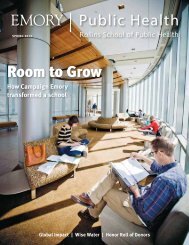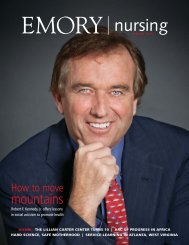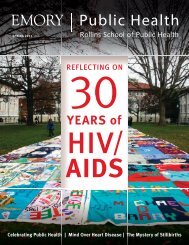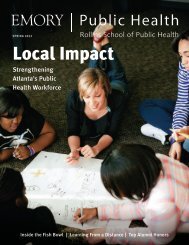returning quality to life - Woodruff Health Sciences Center - Emory ...
returning quality to life - Woodruff Health Sciences Center - Emory ...
returning quality to life - Woodruff Health Sciences Center - Emory ...
Create successful ePaper yourself
Turn your PDF publications into a flip-book with our unique Google optimized e-Paper software.
CLINICAL CARE FOR PATIENTS AND REFERRING PHYSICIANS<br />
When bone marrow goes bad<br />
To this day, the words multiple myeloma<br />
than 50, and African Americans. The aver-<br />
make my heart skip. They take me back<br />
age age of patients at diagnosis is 65.<br />
<strong>to</strong> memories of my mother’s premature<br />
However, Lonial also treats many young<br />
death from this disease, a tenacious can-<br />
patients with the disease, one as young<br />
cer of the plasma cells. Little was known<br />
as 25 and a lot in their 40s. One <strong>Emory</strong><br />
about multiple myeloma in the early 1970s<br />
researcher has shown that the average<br />
when my mother was diagnosed at age 42.<br />
age of African Americans at diagnosis is<br />
Although she had little hope of living long<br />
lower than that in other races.<br />
with the disease, thankfully, times have<br />
Lonial’s research focuses on combining<br />
changed, and things have improved for<br />
new drugs, which are administered in a<br />
those who have multiple myeloma <strong>to</strong>day.<br />
highly regimented order. “The sequence<br />
One of the most famous people <strong>to</strong> ben-<br />
of administration may be very important<br />
efit from knowledge about the disease gar-<br />
because you may block the effect of a<br />
nered over the past 40 years is Geraldine<br />
second drug if the first drug is given out<br />
Ferraro. The first female vice presidential<br />
of order,” Lonial says.<br />
candidate on a major party ticket, Ferraro<br />
Currently, he and his colleagues at<br />
was diagnosed with multiple myeloma in<br />
<strong>Emory</strong>’s Winship Cancer Institute are con-<br />
late 1998. Now, at 75, she is still living<br />
ducting a national epidemiologic study<br />
with this cancer, which her physicians are<br />
able <strong>to</strong> treat like a chronic disease. She has<br />
Geraldine Ferraro has benefited from knowledge<br />
about multiple myeloma that was unavailable at<br />
the time of diagnosis of the author’s mother, Bev<br />
that collects blood samples from more<br />
than 1,000 African Americans with mul-<br />
access <strong>to</strong> an array of therapies and a clini- Tricoles, pictured below.<br />
tiple myeloma. The researchers will use<br />
cal trial.<br />
those samples <strong>to</strong> sequence the genome<br />
Clinical trials are one of the most effective ways <strong>to</strong> treat<br />
<strong>to</strong> see if they can identify genes that are associated<br />
multiple myeloma, according <strong>to</strong> <strong>Emory</strong> oncologist Sagar<br />
with a higher risk of multiple myeloma in African<br />
Lonial at the Winship Cancer Institute. “Although the<br />
Americans.<br />
prognosis for people with this cancer is poor, progress is<br />
Meanwhile, with drug order in mind, research-<br />
being made,” he says. “Twenty years ago, the survival<br />
ers also are interested in identifying new targets in<br />
rate was two <strong>to</strong> three years. Now it’s four <strong>to</strong> five. One<br />
myeloma—targets that may not be broadly repre-<br />
of the keys <strong>to</strong> some patients’ longevity is increasing<br />
sented in all patients. “We have <strong>to</strong> get away from the<br />
enrollment in clinical trials and access <strong>to</strong> <strong>life</strong>-extending drugs.”<br />
idea that myeloma is a single disease,” says Lonial.<br />
Estimates put the number of people in the United States who “It’s not. There are probably about seven or eight genetic subsets of<br />
are living with multiple myeloma in the tens of thousands. <strong>Health</strong>y myeloma. What I think we’ve seen throughout oncology is a revolu-<br />
plasma cells that live in the bone marrow make antibodies that protion on both sides of the equation. We now understand the specifics<br />
tect us from antigens like bacteria and viruses. But if those plasma of cancer better, and we have more <strong>to</strong>ols with which <strong>to</strong> attack this<br />
cells become unhealthy—that is, if they grow unchecked—the<br />
unchecked growth leads <strong>to</strong> multiple myeloma.<br />
This type of cancer results in lytic bone disease, or holes in the<br />
cancer.” —Robin Tricoles<br />
bones. What’s more, the malignant cells crowd out normal bone<br />
WEB CONNECTION To hear an interview with Sagar Lonial, visit<br />
marrow, resulting in anemia or a low white count and leaving a per- http://bitly/lonial. To learn more about progress in hema<strong>to</strong>logy, visit<br />
son vulnerable <strong>to</strong> infections.<br />
http://bitl.y/badmarrow. To learn more about the Winship Cancer<br />
Multiple myeloma is most commonly seen in men, people older Institute, visit cancer.emory.edu.<br />
20<br />
EMORY HEALTH
















